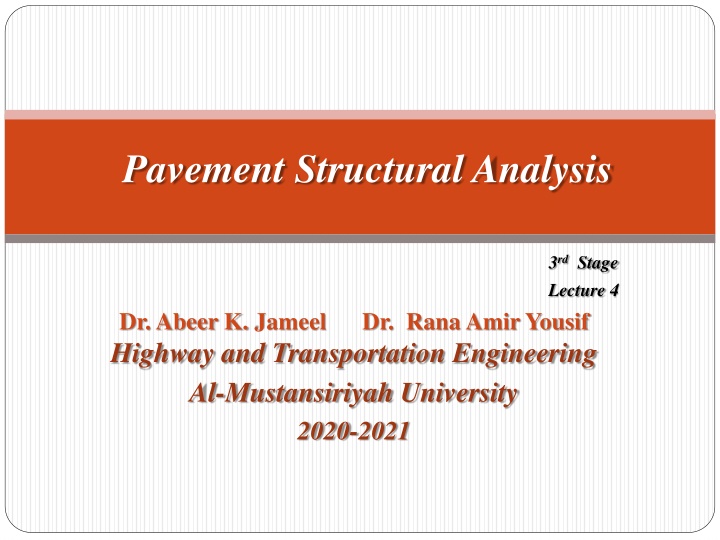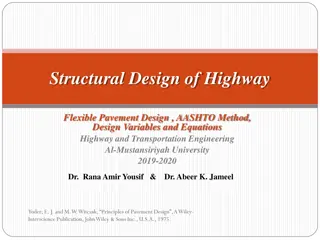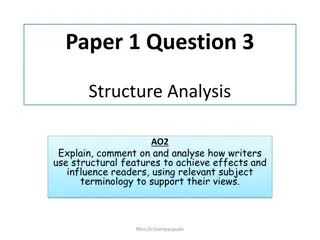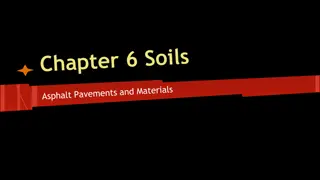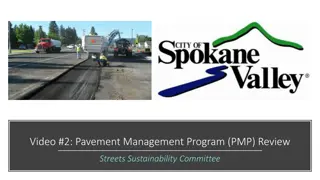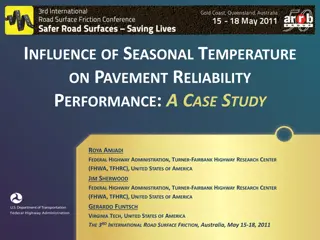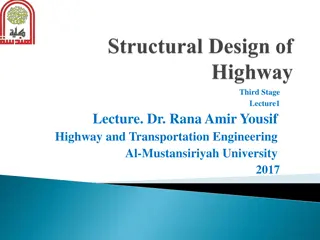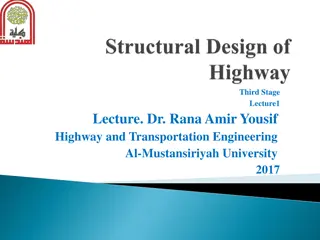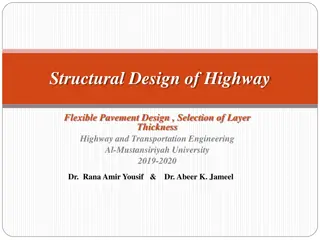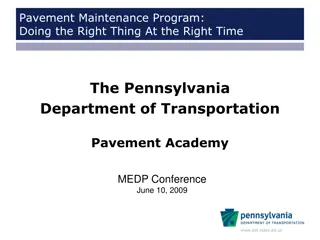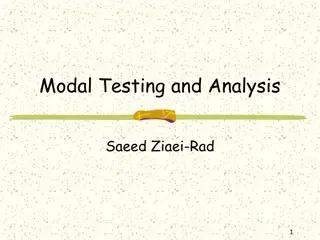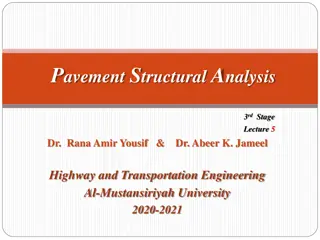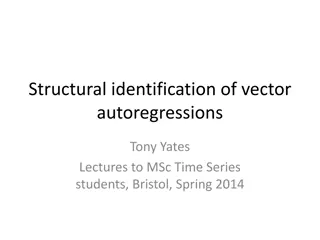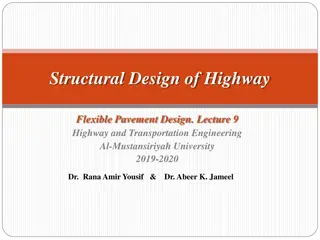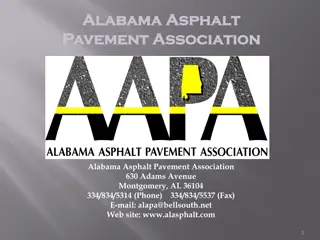Pavement Structural Analysis Techniques
This content discusses stresses in flexible pavements, using Boussinesq theory and charts developed by Foster and Ahlvin to determine vertical, radial, tangential, and shear stresses, as well as vertical deflection. It covers how to compute strains based on obtained stresses, providing insights into pavement pavement structural analysis.
Download Presentation

Please find below an Image/Link to download the presentation.
The content on the website is provided AS IS for your information and personal use only. It may not be sold, licensed, or shared on other websites without obtaining consent from the author.If you encounter any issues during the download, it is possible that the publisher has removed the file from their server.
You are allowed to download the files provided on this website for personal or commercial use, subject to the condition that they are used lawfully. All files are the property of their respective owners.
The content on the website is provided AS IS for your information and personal use only. It may not be sold, licensed, or shared on other websites without obtaining consent from the author.
E N D
Presentation Transcript
Pavement Structural Analysis 3rdStage Lecture 4 Dr. Abeer K. Jameel Dr. Rana Amir Yousif Highway and Transportation Engineering Al-Mustansiriyah University 2020-2021
References: Nicholas J. Garber and Lester A. Hoel. Traffic and Highway Engineering , Fourth Edition. Yoder; E. J. and M. W. Witczak, Principles of Pavement Design , AWiley- Interscience Publication, John Wiley & Sons Inc., U.S.A., 1975. Yaug H. Huang, Pavement Analysis and Design , Prentic Hall Inc., U.S.A., 1993. AASHTO Guide for Design of Pavement Structures 1993 , AASHTO, American Association of State Highway and Transportation Officials, U.S.A., 1993. Oglesby Clarkson H., Highway Engineering , John Wiley & Sons Inc., U.S.A., 1975.
Stresses in Pavements 2.1. Stresses in Flexible Pavements 2.1.1. Stresses in Homogeneous Mass Boussinesq formulated models for the stresses inside an elastic half-space due to a concentrated load applied on the surface. A half-space has an infinitely large area and an infinite depth with a top plane on which the loads are applied. The simplest way to characterize the behavior of a flexible pavement under wheel loads is to consider the subgrade, the sub-base, base, and the surfacing layers to form a homogeneous half-space. If the modulus ratio between the pavement and the subgrade is close to unity, as exemplified by a thin asphalt surface and a thin granular base, the Boussinesq theory can be applied to determine the stresses, strains, and deflections in the subgrade Figure 2-1 shows a homogeneous half- space subjected to a circular load with a radius a and a uniform pressure q. The half space has an elastic modulus E and a Poisson ratio, v. A small cylindrical element with centre at a distance z below the surface and r from the axis of symmetry is shown. Due to ax symmetry, there are only three normal stresses, z, r, and t, and one shear stress, rz, which is equal to rz. These stresses are functions of q, r/ a, and z/ a.
Figure 2-1: Stresses under axisymmetric circular loading Yoder; E. J. and M. W. Witczak, Principles of Pavement Design , A Wiley- Interscience Publication, John Wiley & Sons Inc., U.S.A., 1975.
Foster and Ahlvin have developed charts as provided here from Figure 2-2 to Figure 2-6 for determining vertical stress z, radial stress r, tangential stress t, shear stress rz, and vertical deflection w, assuming the half-space is incompressible with a Poisson ratio of 0.5. After the stresses are obtained from the charts, the strains can be computed from Yoder; E. J. and M. W. Witczak, Principles of Pavement Design , A Wiley- Interscience Publication, John Wiley & Sons Inc., U.S.A., 1975.
If the contact area consists of two circles, the stresses and strains can be computed by superposition. 1 Yoder; E. J. and M. W. Witczak, Principles of Pavement Design , A Wiley- Interscience Publication, John Wiley & Sons Inc., U.S.A., 1975.
1 Yoder; E. J. and M. W. Witczak, Principles of Pavement Design , A Wiley- Interscience Publication, John Wiley & Sons Inc., U.S.A., 1975.
1 Yoder; E. J. and M. W. Witczak, Principles of Pavement Design , A Wiley- Interscience Publication, John Wiley & Sons Inc., U.S.A., 1975.
1 Yoder; E. J. and M. W. Witczak, Principles of Pavement Design , A Wiley- Interscience Publication, John Wiley & Sons Inc., U.S.A., 1975.
1 Yoder; E. J. and M. W. Witczak, Principles of Pavement Design , A Wiley- Interscience Publication, John Wiley & Sons Inc., U.S.A., 1975.
Example: Figure 2.7 shows a homogeneous half-space subjected to two circular loads, each 10 in. (254 mm) in diameter and spaced at 20 in . (508 mm) on centers. The pressure on the circular area is 50 psi (345 kPa) . The half-space has elastic modulus 10,000 psi (69 MPa) and Poisson ratio 0 .5 . Determinethe vertical stress, strain, and deflection at point A, which is located 10 in . (254 mm) below the center of one circle. Yoder; E. J. and M. W. Witczak, Principles of Pavement Design , A Wiley- Interscience Publication, John Wiley & Sons Inc., U.S.A., 1975.
Solution: Given :- q = 50 psi z = 10.0 in a value = D/2 a = 5.0 in Find:- From Figures 2.2 the stresses at point A due to the left load 1 left load 2 z/a = 10/5 =2 r/a= 0/5 = 0 ( z / q)*100 =28 z = 0.28* 50 =14.0 psi Yoder; E. J. and M. W. Witczak, Principles of Pavement Design , A Wiley- Interscience Publication, John Wiley & Sons Inc., U.S.A., 1975.
Solution: Find:- From Figures 2.3 the stresses at point A due to the left load left load z/a = 10/5 =2 r/a= 0/5 = 0 ( r / q)*100 =1.6 r = 0.016* 50 =0.8 psi Yoder; E. J. and M. W. Witczak, Principles of Pavement Design , A Wiley- Interscience Publication, John Wiley & Sons Inc., U.S.A., 1975.
Solution: Find:- From Figures 2.4 the stresses at point A due to the left load left load z/a = 10/5 =2 r/a= 0/5 = 0 ( t / q)*100 =1.6 t = 0.016* 50 =0.8 psi Yoder; E. J. and M. W. Witczak, Principles of Pavement Design , A Wiley- Interscience Publication, John Wiley & Sons Inc., U.S.A., 1975.
Solution: Given :- q = 50 psi z = 10.0 in a value = D/2 a = 5.0 in Find:- From Figures 2.2 the stresses at point A due to the right load right load z/a = 10/5 =2 r/a= 20/5 = 4 ( z / q)*100 =0.76 z = 0.0076* 50 =0.38 psi Yoder; E. J. and M. W. Witczak, Principles of Pavement Design , A Wiley- Interscience Publication, John Wiley & Sons Inc., U.S.A., 1975.
Solution: Find:- From Figures 2.3 the stresses at point A due to the right load right load z/a = 10/5 =2 r/a= 20/5 = 4 ( r / q)*100 =2.6 r = 0.026* 50 =1.3 psi Yoder; E. J. and M. W. Witczak, Principles of Pavement Design , A Wiley- Interscience Publication, John Wiley & Sons Inc., U.S.A., 1975.
Solution: Find:- From Figures 2.4 the stresses at point A due to the right load right load z/a = 10/5 =2 r/a= 20/5 = 4 t = 0 Yoder; E. J. and M. W. Witczak, Principles of Pavement Design , A Wiley- Interscience Publication, John Wiley & Sons Inc., U.S.A., 1975.
Solution: left & right load Find:- By superposition, z = 14 + 0.38 = 14.38 psi r = 0.8 + 1.3 =2.1 psi t = 0.8 psi From Eq.2.1a z= [14 .38 - 0 .5(2.10 + 0.8)]/10,000 = 0 .00129 Yoder; E. J. and M. W. Witczak, Principles of Pavement Design , A Wiley- Interscience Publication, John Wiley & Sons Inc., U.S.A., 1975.
Solution: Find:- From Figures 2.6 the deflection factor at point A F = 0.68 left load Yoder; E. J. and M. W. Witczak, Principles of Pavement Design , A Wiley- Interscience Publication, John Wiley & Sons Inc., U.S.A., 1975.
Solution: Find:- From Figures 2.6 the deflection factor at point A F = 0.21 right load Yoder; E. J. and M. W. Witczak, Principles of Pavement Design , A Wiley- Interscience Publication, John Wiley & Sons Inc., U.S.A., 1975.
Solution: Find:- left & right load F = 0.68 + 0.21 w = (0 .68 + 0 .21) * 50 * 5/10,000 = 0 .022 in The final answer is z = 14.38 psi z= 0.00129, w = 0.022 in The results obtained from KENLAYER are z = 14.6 psi z= 0.00132, w = 0.0218 in which check closely with those from the charts. Yoder; E. J. and M. W. Witczak, Principles of Pavement Design , A Wiley- Interscience Publication, John Wiley & Sons Inc., U.S.A., 1975.
Pavement Structural Analysis Dr. Rana Amir Yousif & Dr. Abeer K. Jameel Yoder; E. J. and M. W. Witczak, Principles of Pavement Design , A Wiley- Interscience Publication, John Wiley & Sons Inc., U.S.A., 1975.
